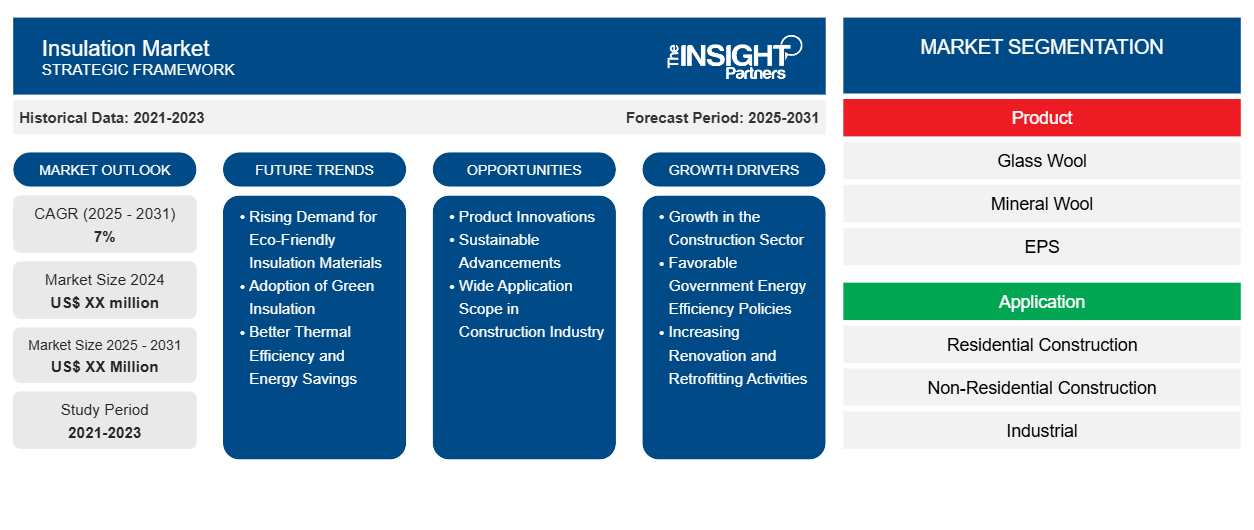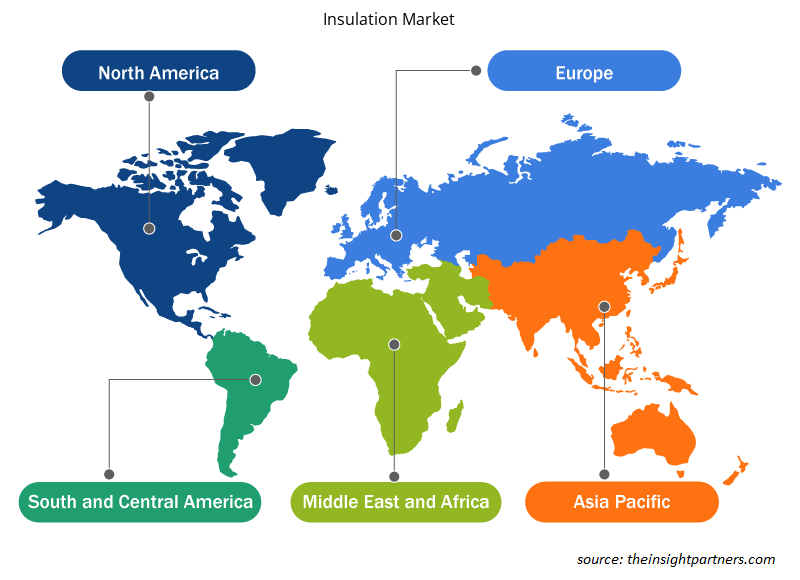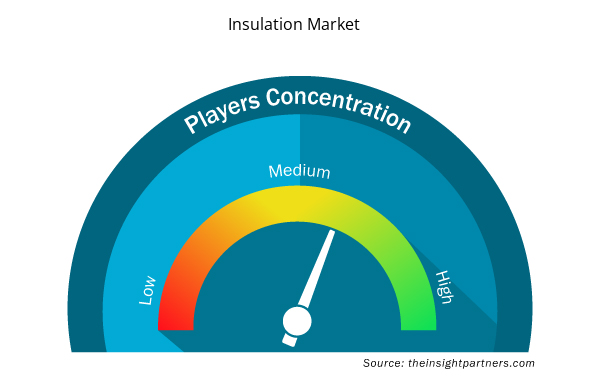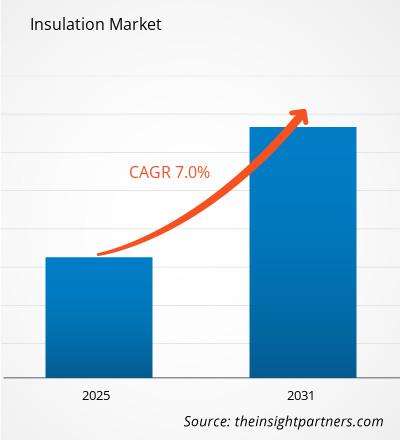The Insulation Market is expected to register a CAGR of 7% from 2025 to 2031, with a market size expanding from US$ XX million in 2024 to US$ XX Million by 2031.
The report presents analysis based on product (glass wool, mineral wool, EPS, and XPS). The report is segmented by application (residential construction, non-residential construction, industrial, and HVAC and OEM). The global analysis is further broken-down at regional level and major countries. The market size and forecast at global, regional, and country levels for all the key market segments are covered under the scope. The report offers the value in USD for the above analysis and segments. The report provides key statistics on the market status of the key market players and offers market trends and opportunities.
Purpose of the Report
The report Insulation Market by The Insight Partners aims to describe the present landscape and future growth, top driving factors, challenges, and opportunities. This will provide insights to various business stakeholders, such as:
- Technology Providers/Manufacturers: To understand the evolving market dynamics and know the potential growth opportunities, enabling them to make informed strategic decisions.
- Investors: To conduct a comprehensive trend analysis regarding the market growth rate, market financial projections, and opportunities that exist across the value chain.
- Regulatory bodies: To regulate policies and police activities in the market with the aim of minimizing abuse, preserving investor trust and confidence, and upholding the integrity and stability of the market.
Insulation Market Segmentation
Product
- Glass Wool
- Mineral Wool
- EPS
- XPS
Application
- Residential Construction
- Non-Residential Construction
- Industrial
- HVAC and OEM
Customize This Report To Suit Your Requirement
You will get customization on any report - free of charge - including parts of this report, or country-level analysis, Excel Data pack, as well as avail great offers and discounts for start-ups & universities
Insulation Market: Strategic Insights

- Get Top Key Market Trends of this report.This FREE sample will include data analysis, ranging from market trends to estimates and forecasts.
Insulation Market Growth Drivers
- Growth in the Construction Sector: The high increase in the construction sector is significantly impacting the insulation industry, primarily because it can increase demand for energy-saving buildings. With rapid urbanization, developers are becoming more concerned with a sustainable approach to construction, most often that results in using better insulation products. This decreases energy spending and utility costs, making insulated structures more attractive to buyers.
- Favorable Government Energy Efficiency Policies: Another aspect contributing to this growth is the government's energy efficiency policies. Many countries have implemented stiff building codes, which make raising the insulation standards in buildings is mandatory. This forces the building contractors to invest in improving insulation techniques. Therefore, the market grows because of governmental pressure to add insulation to new buildings.
- Increasing Renovation and Retrofitting Activities: It is also being supported by renovation and retrofitting activities. Housing and commercial operators are becoming more keen to renovate their properties for improved energy efficiency as well as comfort inside the properties. Under such projects, insulation becomes an imperative requirement, thus fostering demand for modern, high-performance materials in the insulation industry.
Insulation Market Future Trends
- Rising Demand for Eco-Friendly Insulation Materials: The primary trend that is shaping the future of the insulation market is the increasing demand for environmentally friendly insulation materials. Also, as environmental awareness is increasing, consumers and builders are adopting alternatives that can minimize carbon footprints. Cellulose, wool, and recycled plastics are some of the increasingly popular eco-friendly materials that provide minimal environmental impact.
- Adoption of Green Insulation: Worldwide, governments are incentivizing green building through sustainable materials. Incentives, tax credits, and regulations support the use of eco-friendly insulation for both newly constructed buildings and renovations. Besides increasing the demand in the market, such regulations will also further push innovation into green insulation.
- Better Thermal Efficiency and Energy Savings: Another benefit that is linked with green insulation products is generally better thermal efficiency, appealing to energy-conscious buyers. Such products improve building energy efficiency, which lowers heating and cooling bills. With increasing energy prices, higher savings are experienced from using green insulation products, hence driving the market growth.
Insulation Market Opportunities
- Product Innovations: Material innovation can be regarded as the biggest growth opportunity for the insulation market. Manufacturers will continue introducing new materials that will offer better insulation, higher thermal resistance, and better energy efficiency. Innovations such as vacuum insulation panels and aerogels are superior insulators with insulation properties, which appeal to builders and consumers seeking high-performance solutions for their projects.
- Sustainable Advancements: Another trend in the market is sustainable material advancement. Bio-based insulations, such as sheep's wool and hemp insulations, are growing in popularity today. These innovations not only respond to the growing demand for more sustainable consumer needs but also comply with the overall global sustainability strategies and attract new market segments.
- Wide Application Scope in Construction Industry: Besides, multirôle insulating materials also broaden the application range. Insulation with incorporation for sound absorption or moisture management has seen increased demand in both domestic and commercial buildings. This versatility is added to the appeal of such products since builders and architects look for solutions that could affect several needs within one product.
Insulation Market Regional Insights
The regional trends and factors influencing the Insulation Market throughout the forecast period have been thoroughly explained by the analysts at Insight Partners. This section also discusses Insulation Market segments and geography across North America, Europe, Asia Pacific, Middle East and Africa, and South and Central America.

- Get the Regional Specific Data for Insulation Market
Insulation Market Report Scope
| Report Attribute | Details |
|---|---|
| Market size in 2024 | US$ XX million |
| Market Size by 2031 | US$ XX Million |
| Global CAGR (2025 - 2031) | 7% |
| Historical Data | 2021-2023 |
| Forecast period | 2025-2031 |
| Segments Covered |
By Product
|
| Regions and Countries Covered | North America
|
| Market leaders and key company profiles |
Insulation Market Players Density: Understanding Its Impact on Business Dynamics
The Insulation Market market is growing rapidly, driven by increasing end-user demand due to factors such as evolving consumer preferences, technological advancements, and greater awareness of the product's benefits. As demand rises, businesses are expanding their offerings, innovating to meet consumer needs, and capitalizing on emerging trends, which further fuels market growth.
Market players density refers to the distribution of firms or companies operating within a particular market or industry. It indicates how many competitors (market players) are present in a given market space relative to its size or total market value.
Major Companies operating in the Insulation Market are:
- BASF
- Atlas Roofing Corporation
- Bayer
- Byucksan Corporation
- Compagnie de Saint-Gobain S.A.
Disclaimer: The companies listed above are not ranked in any particular order.

- Get the Insulation Market top key players overview
Key Selling Points
- Comprehensive Coverage: The report comprehensively covers the analysis of products, services, types, and end users of the Insulation Market, providing a holistic landscape.
- Expert Analysis: The report is compiled based on the in-depth understanding of industry experts and analysts.
- Up-to-date Information: The report assures business relevance due to its coverage of recent information and data trends.
- Customization Options: This report can be customized to cater to specific client requirements and suit the business strategies aptly.
The research report on the Insulation Market can, therefore, help spearhead the trail of decoding and understanding the industry scenario and growth prospects. Although there can be a few valid concerns, the overall benefits of this report tend to outweigh the disadvantages.
- Historical Analysis (2 Years), Base Year, Forecast (7 Years) with CAGR
- PEST and SWOT Analysis
- Market Size Value / Volume - Global, Regional, Country
- Industry and Competitive Landscape
- Excel Dataset



Report Coverage
Revenue forecast, Company Analysis, Industry landscape, Growth factors, and Trends

Segment Covered
This text is related
to segments covered.

Regional Scope
North America, Europe, Asia Pacific, Middle East & Africa, South & Central America

Country Scope
This text is related
to country scope.
Frequently Asked Questions
The growing demand for eco-friendly insulation materials is expected to be the key market trends.
Based on product, the mineral wool segment is expected to witness the fastest growth during the forecast period
Based on geography, Asia Pacific held the largest share of the insulation market due to the region's strong construction sector, driven by ongoing industrial and commercial development.
The growing construction industry is driving the market growth.
Owens Corning; Saint-Gobain; Knauf Insulation; ROCKWOOL International A/S; Armacell; Kingspan Group; NICHIAS Corporation.; Etex Group; and Thomas Insulation Corporation are some of the key players operating in the insulation market
The Insulation Market is estimated to witness a CAGR of 7% from 2023 to 2031
Trends and growth analysis reports related to Chemicals and Materials : READ MORE..
1. BASF
2. Atlas Roofing Corporation
3. Bayer
4. Byucksan Corporation
5. Compagnie de Saint-Gobain S.A.
6. Dow Chemical Company
7. Guardian Building Products Inc.
8. Huntsman Corporation
9. Johns Manville
10. Kingspan Group plc

 Get Free Sample For
Get Free Sample For